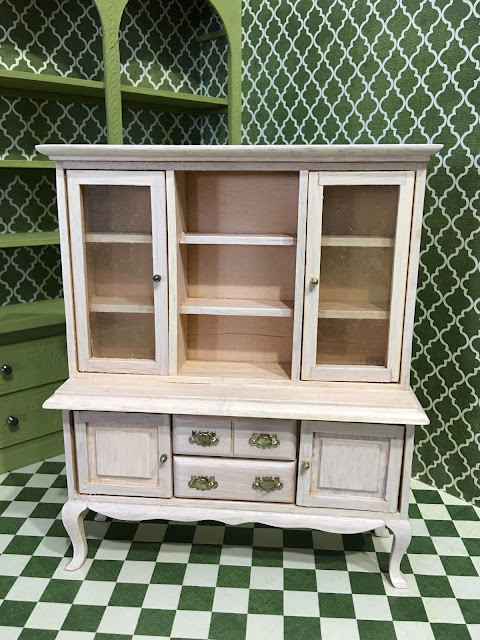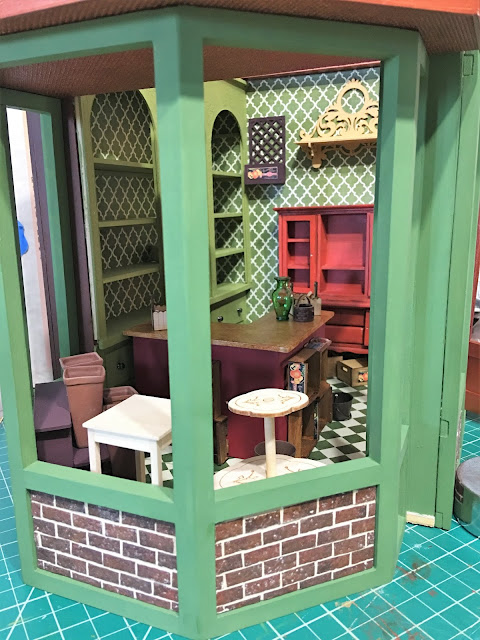I began by cutting the Lexan (polycarbonate) for all seven of the windows, as well as the shop's top. You see, Carlson kits do not come with acetate (except for the door). I have used this material in the past and just love the 1/16" thickness and the ease in cutting it, provided you have the scoring tool. It takes me about 44 passes with the scoring tool, and then I can snap at the score line and finish off the last couple passes with my Xacto knife.
Here I am testing the fit. In this type of window, a pretty perfect fit is the best outcome. The second photo shows me sanding down the really snug areas.
All cut!
Now for the trim. I used 1/8" x 1/16" basswood, painted on all sides. I created a frame around the outside of the windows and affixed them with regular Tacky Glue. Tacky Glue isn't always reliable on acetate, but on Lexan, it attaches securely.
Next I installed the windows using wood glue (because of it's runny constancy) as caulking where the frames met. I have a small glue applicator bottle with a 1/32" tip. This allows me to apply a bead of glue to the seam, then run my finger along to smooth and remove excess just as you do when caulking a real life sink. Once the exterior was dry, I cut and installed the interior trim pieces in the same manner. A coat of careful painting did the rest.
I was really looking forward to the next step - making the stained glass windows for the small upper windows on the front of the shop. Once I had sample pieces taped in place, though, I didn't like them! They only served to block one of my favorite features looking in through the front - the arched upper shelves! Because I was so prepared (bought supplies) and so excited about doing them, I did go ahead and play with some techniques. I will share all of that in a later post.
Now, with that decision behind me, it was time to regroup. I turned my attention to finishing up the structural elements. I made up and installed the wall that attaches the bay window section to the main section. This is just two pieces, wall and header, of 1/8" basswood sheet ripped down to size then glued in.
I kept thinking that in a completely enclosed project like this, the windows had to look really interesting from the outside. This niggled at me for a couple days and then I realized: I needed a shelf to create window displays in the bay! So, I traced the dimensions onto some more 1/8" basswood sheet and cut out an inch wide shelf. I attached 1/8" x 1/8" basswood strips to recess into the window wells so there wouldn't be any gap.
 |
| From the outside |
The next task was not as friendly. You see, I wanted the windows to have awnings, but I wasn't really sure how to make them. I Googled but couldn't find an actual awning pattern. I settled for some patterns that had the scalloped edging, then used my PC to edit them a bit. Then I imported the best image into the Cricut Design Space and made not only the awnings, but the valences for the interior of the shop, too. It took me four tries, six sheets of nice scrapbook paper and a new blade to get them right. I used a polka dot pattern for the interior/underside and a striped paper for the exposed side. I left them on the sticky mat to help hold them in place while I Mod Podged the two sides together. Once dry, I applied the Mod Podge to each of the sides, letting them dry in between.
I wanted to see if something really simple would work, and it did! In design space, I took the original scalloped edge image and welded a rectangle to the back. For those that have no idea about Cricut terms, I'll just leave it that I adjusted the size so that there would be a .75 inch scallop, a 1.25 inch awning, and a .25 inch strip to adhere to the structure. I made each awning fit the windows with a .25 inch overhang on each side. I used basswood strips in matching sizes to help me fold them evenly, then I attached above each of the windows using Fast Grab Tacky glue.
The valences inside just show at the top of the windows.
And the exterior awnings. Look Ma! No hands or bracing!
Oh, and here is the Lexan installed in the roof.
I had to make a final decision on how the front of the shop would not fall over. #$%& Gravity! The blue tape just doesn't complement the aesthetic I'm trying for here! Not being able to find my pack of magnets was all I needed to push me in the direction of option two: Having a lip on the ceiling piece to keep the front in place. But that had me thinking about what kind of things were going to be in front of the wall, as in landscaping. In order to get a good visual on that, I had to decide on and make the landscape board. I just happened to have some 12" x 24" x 1/4" birch plywood. Since I decided on a base of 13-1/2" x 18", I simply had to cut down my piece of plywood and laminate a 1-1/2" strip to it. No matter what I put in front of the front wall, as long as I leave a space for it to slide to the right for removal (which won't be often), I'll be okay.
The next goal I wanted to achieve for the week was to get the lighting completed. I went through my stash of lights and found some I thought could work. There will be a total of 7 interior lights, 2 exterior lights by the front door, and space to add at least two additional landscape lights. These were all purchased for other projects back in the days when I did not plan my spaces so well. Lucky for me, now I have them to use in the shop! Somebody up there has my back!
Shiny gold fixtures just weren't going to do, so using two coats of burnt sienna, a glaze/real brown pouncing, then another burnt sienna/glaze pouncing I made them rusty.
 |
| Great way to hold drying light fixtures. |
I had to find a way to run the wiring for the chandelier, A beam seemed like the obvious choice for a structure with a clear ceiling. I used some leftover channel molding to run the wire through to the right side wall, then capped it off with a piece of 1/16" trim. To accommodate the chandelier's ceiling cap, I laminated 3 round Woodsies to each other (for thickness), cut them in half, then added a half to each side of the beam. To balance the feeling in the store, I added sister beams on either side with support beams attached to the walls underneath.
I thought it might be fun to add the sconces to Deb's favorite wall shelves (how adorable is her half scale garden!!!). That meant I had to stop and make up some leafy plants to fill them. Hello 1:00 AM! Can somebody please explain to Woodson that when you go to bed at 1:00 AM you get to sleep until 9:00 AM? Not 6:22 AM!!!
The next challenge was: How To Conceal The Wiring Coming Out The Side Of The Shop? The answer: More channel molding done in a way that looks intentional. I may add produce posters to the upper boxed frames.
And how about the wiring coming from the front exterior lights? To keep the ceiling/roof/top removable, these have to be attached to the ceiling/roof/top and be unplugged from the power strip as needed. Another channel for wires, this time with stripwood.
And what does all this look like from the back? Additional "Final Tidying" is on "The List". Kind of looks like a spooky tree. Hey! There's an idea!
And after all this work, do they work?
Yeah!!! They Work!!!
And I hope everything is working right for all of you, too!
xo xo,
Jodi

















































































